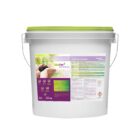Description
Recommendations for use:
– In crops with a high zinc requirement: maize, potatoes, cereals, vegetable and fruit crops.
– In conditions of nutrient deficiency – intervention and prevention.
– To stimulate the development of the root system and increase the absorption of nutrients from the soil: nitrogen, phosphorus and potassium
– To increase resistance to stress conditions and pathogens
– To increase and improve crop quality and storability parameters.
| MACROELEMENTS | % weight | % volume |
|---|---|---|
| Nitrogen (N) | 5.00 | 6.50 |
| Potassium (K2O) | 2.00 | 2.60 |
| Sulfur (SO3) | 5.50 | 7.15 |
| MICROELEMENTS | % weight | % volume |
| Zinc (Zn) | 15.000 | 19.500 |
The role of zinc in crops:
- Regulates the hormonal balance of the plant and favourably influences the photosynthetic process
- Increases resistance to fungal diseases and prolongs the “green leaf” effect
- Influences quality and quantity of the yield: high starch, oil and vitamin content.
- Improves efficiency of nitrogen fertilisation
Zinc deficiencies result in:
- Chlorosis: white-yellow spots on leaf tips
- Dwarfing of plants
- Reduction in the formation of flower buds
- Shortening and curling of leaves, in extreme conditions leaf dieback may occur
- Shortening and dieback of lateral shoots, which can occur in extreme conditions
Dosage and application:
| Crop | Dose (l/ha) | Number and Timing of Treatments |
|---|---|---|
| Sugar Beet | 0.5-1 | 3 treatments: from the 4-6 leaf stage to canopy closure (BBCH18-39) every 12-14 days |
| Apple and Pear Trees | 0.75-1.5 | 3-4 treatments: 1-2 treatments as a preventative measure or after symptoms of zinc deficiency and 2 treatments: a few weeks before the harvest to improve the basic stability and correct color of the fruit (BBCH 55-59), at intervals of 12-14 days |
| Berries | 0.75-1.5 | 3-4 treatments: 1 intervention or supplementary treatment, in autumn – after harvest up to 3 treatments, every 12 days (recommended dose 1l/ha) |
| Maize | 0.75-1 | 2 treatments: from the 3-5 leaf stage (BBCH 15-18) every 7-12 days |
| Other Field Vegetables | 0.5 | 1-2 treatments: at any stage of development, when symptoms of zinc deficiency appear on the plants or during periods unfavorable for zinc uptake, at intervals of 12-14 days |
| Winter Oilseed Rape | 0.5 | 2 treatments: in autumn from the 4-6 leaf stage to two weeks before the end of autumn vegetation (BBCH 20-25), in spring from the start of vegetation to the beginning of bud development (BBCH 30-51) |
| Legumes | 0.5-1 | 2-3 treatments: from emergence to flower bud stage (BBCH 21-59), every 9 days |
| Ground Vegetables with High Zinc Requirements | 0.5 | 3 treatments: first during intensive growth, after at least 8-9 leaves have developed, subsequent treatments at intervals of 12-14 days (also recommended when deficiency appears) |
| Cherries and Plums | 0.75-1.5 | 5-7 treatments: in spring – 2 treatments from the bud burst to the green bud stage (recommended dose 0.75-1.0 l/ha), in summer (especially on apple trees) – several treatments after June bud drop (recommended reduced dose 0.1 – 0.15 l/ha), after harvest: up to 3 treatments, 14 day intervals (recommended dose 1.5 l/ha) |
| Spring Cereals | 0.3 | 2 treatments: from the 3-4 leaf stage to the earing stage (BBCH 13-51), at intervals of 12-14 days |
| Winter Cereals | 0.5 | 3 treatments: in autumn – one treatment from the 3-4 leaf stage until two weeks before the end of autumn vegetation (BBCH 13-25), in spring – 2 treatments from the start of vegetation until the end of the stem elongation stage (BBCH 25-51) |
| Potatoes | 0.5-1 | 2 treatments: from the shoot formation stage until 40% of the final weight of the tubers is reached (BBCH 35-73), at intervals of 12-14 days |
VitaFer® Extra Zn can be used at the indicated developmental stages of crops or when symptoms of zinc deficiency are found on crops in order to eliminate them.









